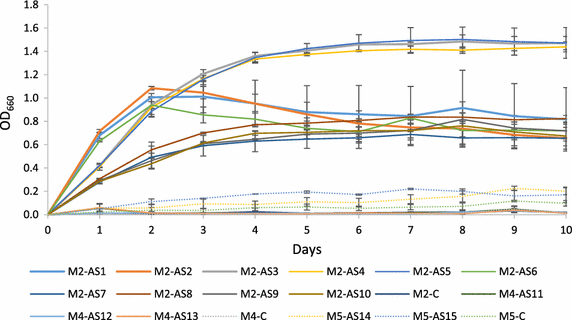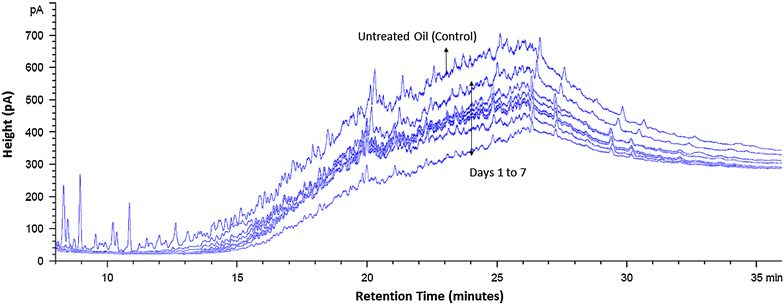Microbial enhanced heavy crude oil recovery through biodegradation using bacterial isolates from an Omani oil field
- PMID: 26377922
- PMCID: PMC4573931
- DOI: 10.1186/s12934-015-0330-5
Microbial enhanced heavy crude oil recovery through biodegradation using bacterial isolates from an Omani oil field
Abstract
Background: Biodegradation is a cheap and environmentally friendly process that could breakdown and utilizes heavy crude oil (HCO) resources. Numerous bacteria are able to grow using hydrocarbons as a carbon source; however, bacteria that are able to grow using HCO hydrocarbons are limited. In this study, HCO degrading bacteria were isolated from an Omani heavy crude oil field. They were then identified and assessed for their biodegradation and biotransformation abilities under aerobic and anaerobic conditions.
Results: Bacteria were grown in five different minimum salts media. The isolates were identified by MALDI biotyper and 16S rRNA sequencing. The nucleotide sequences were submitted to GenBank (NCBI) database. The bacteria were identified as Bacillus subtilis and B. licheniformis. To assess microbial growth and biodegradation of HCO by well-assay on agar plates, samples were collected at different intervals. The HCO biodegradation and biotransformation were determined using GC-FID, which showed direct correlation of microbial growth with an increased biotransformation of light hydrocarbons (C12 and C14). Among the isolates, B. licheniformis AS5 was the most efficient isolate in biodegradation and biotransformation of the HCO. Therefore, isolate AS5 was used for heavy crude oil recovery experiments, in core flooding experiments using Berea core plugs, where an additional 16 % of oil initially in place was recovered.
Conclusions: This is the first report from Oman for bacteria isolated from an oil field that were able to degrade and transform HCO to lighter components, illustrating the potential use in HCO recovery. The data suggested that biodegradation and biotransformation processes may lead to additional oil recovery from heavy oil fields, if bacteria are grown in suitable medium under optimum growth conditions.
Figures










References
-
- Lazar I, Petrisor IG, Yen TF. Microbial enhanced oil recovery (MEOR) Pet Sci Technol. 2007;25(11):1353–1366. doi: 10.1080/10916460701287714. - DOI
-
- Sen R. Biotechnology in petroleum recovery: the microbial EOR. Prog Energy Combust Sci. 2008;34(6):714–724. doi: 10.1016/j.pecs.2008.05.001. - DOI
-
- Bachmann RT, Johnson AC, Edyvean RGJ. Biotechnology in the petroleum industry: an overview. Int Biodeterior Biodegrad. 2014;86(Part C(0)):225–237. doi: 10.1016/j.ibiod.2013.09.011. - DOI
-
- Prince RC, Gramain A, McGenity TJ. Prokaryotic hydrocarbon degraders. In: Timmis K, editor. Handbook of hydrocarbon and lipid microbiology. Berlin Heidelberg: Springer; 2010. pp. 1669–1692.
MeSH terms
Substances
LinkOut - more resources
Full Text Sources
Other Literature Sources
Miscellaneous

